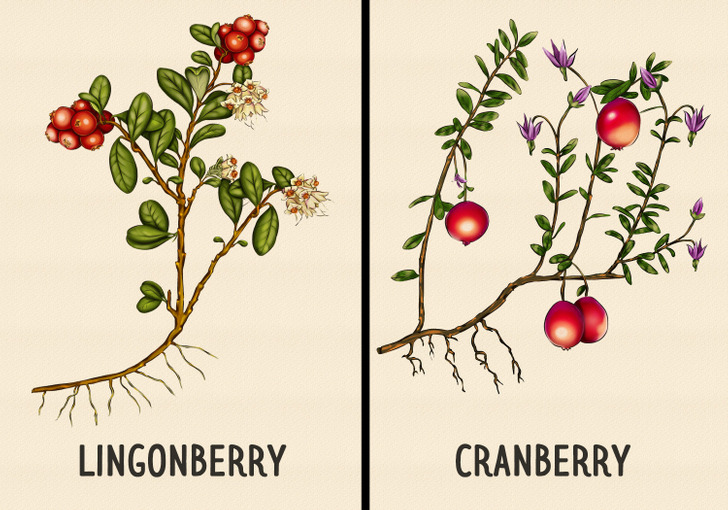The Difference Between a Cranberry and a Lingonberry
Lingonberries and cranberries have a lot in common. Both plants love forests, have red sour berries, and thick green leaves. But there are also many differences between them.
Together with 5-Minute Crafts, you will find out how to tell a cranberry from a lingonberry.
🔶 Where they grow:
- Cranberries prefer acidic soils and, such as bogs and marshes and open moist forests.
- Lingonberries also love open spaces but they don’t always require a lot of moisture. They can grow on rocky ledges, screes, sea cliffs, hilly rocky barrens, mountain summits, high moors, heath barrens, sand dunes, and in peat lands, forest swamps, and bogs. They prefer soils with few minerals and peat.
🔶 Leaves and stems:
- Lingonberry leaves are oval, from 0.2 to 1.2 in long, with a folded edged at the bottom. In spring and summer they are bright green, waxy, and shiny at the top, and in fall, they change color and become purplish. The stems are rounded, from 4 to 15 in tall. They have very branchy roots.
- Cranberry stems are slender, the branches are very thin, more like wire. The leaves are small (1/4 to 1/3 inch long and 1/10 to 2/10 inch wide), elongated, tapering to a point, with a dark-green upper surface and pale-green inner side.
🔶 Flowers:
- Lingonberry flowers are not big, about 0.3 in long and bell-shaped. Every flower is white with big pinkish 4-5 petals growing together at the base.
- Cranberry leaves are also small, but more like white-pinkish lilies. They appear on long stalks, they have 4 narrowly lanced shaped petals that tightly curl back. Projecting from the center is a tight cluster of long, slender reddish stamens and a single slender style.

🔶 Berries:
- Lingonberries can be bright red or dark-red, in groups. The size varies from 0.2 to 0.4 inch. The taste is acidic to sour or bitter. They might even be sweet.
- Cranberries are also round and red, usually bigger than lingonberries: 0.4–0.6 inches in diameter. They are juicy, very sour, and become sweeter after they are frozen. Cranberry fruits grow separately, on long thin stems.
🔶 When it grows:
- Cranberry flowers from June to August, and fruits appear from October to December.
- Lingonberry flowers appear from May to June, and berries appear from August to October.
🔶 Nutrients:
- Cranberries are mostly water, but they also contains fiber and carbs. 1 cup of fresh cranberries contains 46 calories, 12 grams of carbs, and 3,6 grams of fibers. A cup of cranberries contains 14 mg of vitamin C (15 % of the daily norm) and 1.3 mg or vitamin E (around 9% of the daily norm). Also, cranberries are a great source of manganese.
- 100 grans of lingonberries contain 53 calories, 11,5 grams of carbs, and 3,7 grams of fibers. The berries contain a lot of organic acids, vitamins A, C, B, and calcium, magnesium, and phosphorus.
🔶 Why it’s good for you:
- Cranberry can be used to prevent urinary tract infections and protect you from kidney stones. Cranberries may influence the level of cholesterol in the blood and have a positive effect on the health of your cardiovascular system.
- Lingonberry contains 2 times more antioxidants than cranberry and 4 times more than blackberries. Its berries may have a positive effect on blood sugar level and support the health of the brain. The berries have antibacterial properties and might be used to alleviate urinary tract symptoms.
Share This Article